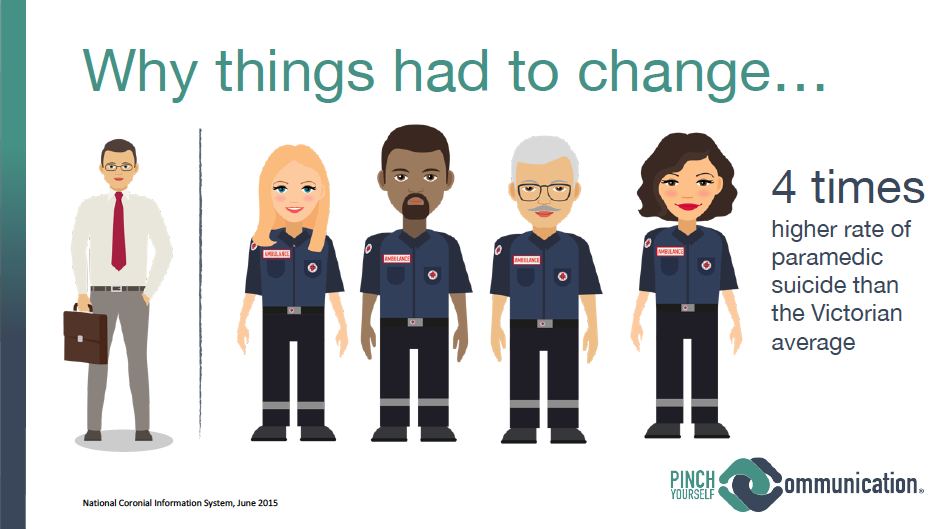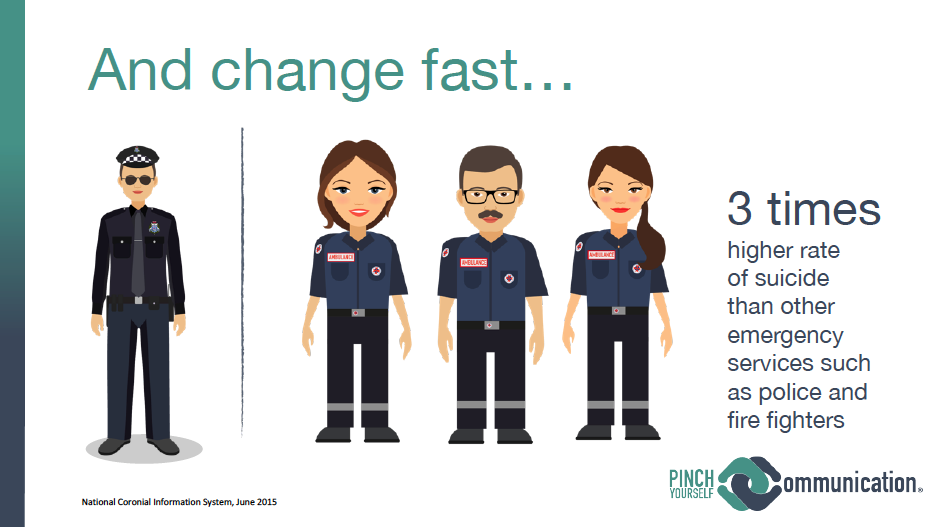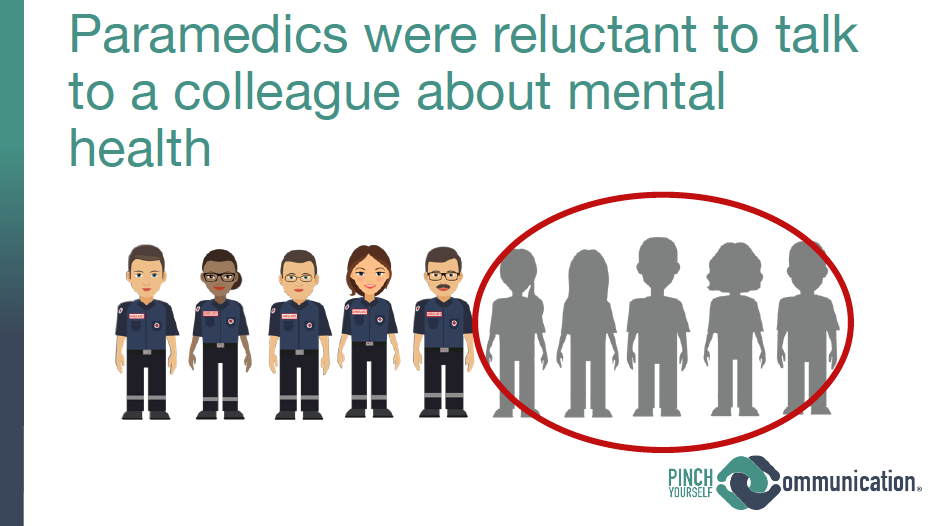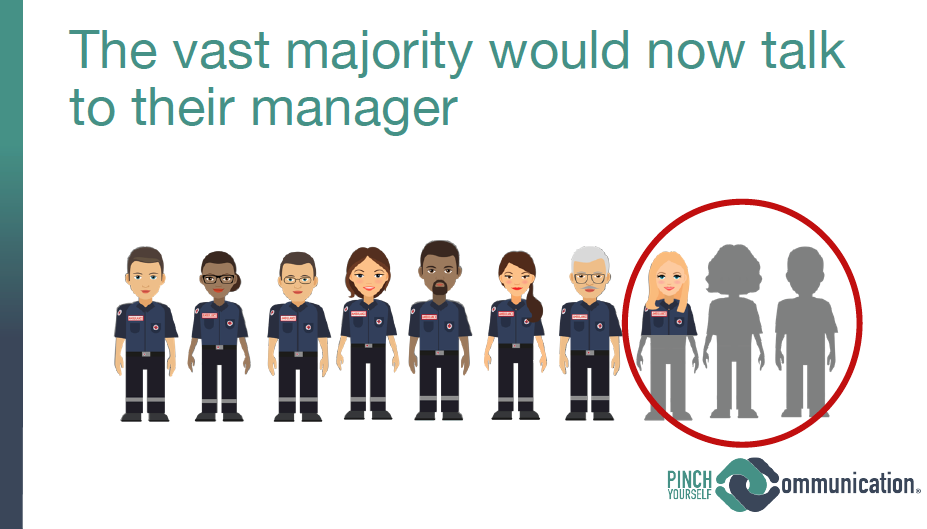A young woman sits at her keyboard to write an article, but her chest feels like it’s crushed in a vice and pain stabs her left arm. Classic symptoms of a deadly condition, or so she thinks. As unlikely as it seems for a woman in her 20s, she must be having a heart attack. She tells nearby co-workers, and they urge her to see the company nurse.
That’s where she learns she’s not having a heart attack. She’s suffering from an acute mental health issue. It’s a severe stress reaction brought on by a court case the young journalist has sat through for days — a case involving the vicious bashing and rape of an elderly grandmother in her own home for which the journalist will now be debriefed by a qualified psychologist.
Putting yourself in this journalist’s shoes, would you speak up to your colleagues if you thought you were having a heart attack?
What if you thought you were having a mental health episode?
I’ve thought a fair bit about the answer to those questions, because the young journalist was me at an earlier point in my career.
How might this have played out had I suspected my issue was mental, not physical? Would I have spoken up so readily or suffered in silence as so many employees do across industries, age groups, genders and the globe?
The mental health stigma is one of the biggest barriers to people getting the support they need.
In addition to raising awareness of mental health symptoms and where to seek help, addressing stigma is perhaps the greatest area where communication professionals can contribute to creating mentally healthy workplaces.
That’s one of seven insights I gathered after leading the communication strategy on a life-saving mental health program by Ambulance Victoria (AV). AV employs about 5,000 paramedics who provide emergency pre-hospital care for almost 7 million people in the Australian state of Victoria.

Tragically, in 2015, the rate of suicide by Victorian paramedics was four times the state average and three times that of other emergency services personnel such as police and fire fighters.

AV CEO Prof. Tony Walker, ASM, recognized that something had to change. How could the organization create a work environment where people felt safe to speak up about mental health and get the support they needed? Communicators can follow these seven recommendations for prioritizing mental health and supporting employees in the workplace.
1. Partner with the experts.
When people’s well-being and lives are at risk, it’s not a time for guesswork or experimenting. AV partnered with mental health organizations beyondblue, Phoenix Australia Centre for Posttraumatic Mental Health and Black Dog Institute. Mental health experts bring much-needed expertise and credibility to your research, strategy and programs and offer external voices to start a conversation with your workforce.
2. Stigma is a barrier and a symptom.
As well as creating fear to speak up and get help, stigma can make symptoms worse for people with a mental health concern, exacerbating feelings of isolation, anxiety and depression. Reducing stigma as both a barrier and a symptom is core to any mental health strategy, including addressing its intersection with diversity, equity and inclusion.

Because of the stigma, fewer than half the paramedics were comfortable to talk about their mental health concerns to a colleague, and 40% said they wouldn’t talk to their manager. Along with training to help staff recognize symptoms and understand available support, AV fostered safe conversations within teams by encouraging staff to make a “mental health pledge” about what they would do differently. The CEO and other executives showed transparent leadership by sharing their own mental health experiences.
3. Mental health factors may not be obvious.
It may be surprising to learn the trauma a paramedic deals with on a daily basis is not necessarily the biggest factor impacting their mental health. Administrative factors also take their toll, including shift work and its impacts on sleep and relationships, as well as unplanned overtime which causes stress and family conflict.
Additionally, the COVID-19 pandemic has increased the prevalence of mental health concerns around the world, with recent Australian research finding major depressive disorder and anxiety disorders have increased by more than 25% worldwide. During the pandemic, health and support agencies around the globe have reported significant spikes in people seeking help.
If there’s any silver lining from the pandemic, it’s that mental health has gone from being perceived as an issue for the few to a potential concern for many and, as a result, the conversation is becoming more open.
The mental health factors affecting your employees may not be obvious, so it’s important to seek their input. Conduct surveys, hold focus groups, provide channels for people to give feedback and use the insights to target well-being initiatives and communication activities where it will do the most good for your people.
4. Integrate communication from the outset.
This feels obvious for us as communication professionals, yet how often is the communication function brought to the table only when an initiative is “ready to launch”?
When AV’s Mental Health and Wellbeing Strategy 2016–2019 was written, key aspects of the communication strategy were included in the organizational strategy. By making the promotion of mental health at all levels of the organization one of the four strategic objectives, we entrenched the organizational commitment to ongoing communication.
5. Avoid the temptation to launch and leave.
To achieve meaningful and lasting change, any cultural shift takes shared purpose, commitment and teamwork. That’s particularly true in tackling stigma.
The AV mental health strategy started with a three-year framework, and AV continues to review and build upon that initial work. After the first year, paramedics were already more willing to talk to someone. Less than one third indicated they would not speak to a colleague, which was down from 50% or more. Fewer than 25% were unwilling to speak to their manager, which was down from 40%. Some 90% or more were now able to identify the warning signs and were familiar with self-care strategies and the available treatments and supports.


6. Authentic storytelling is not easy, but it works.
Storytelling is a powerful weapon against stigma, but it can take creativity and persistence to get people talking about their mental health.
At AV, we found paramedics’ family members — a wife, a mother and a husband — who were willing to speak on camera, and their comments were moving and powerful. A couple of years on, one of the biggest symbols of success was finding paramedics willing to tell their own story. One paramedic was featured in the Ambulance Today magazine, along with an in-depth look at the AV case study.
7. You can’t help others if you don’t look after yourself.
Communicators are good at putting the needs of the business ahead of their own, and unfortunately that’s reflected in United Kingdom and Australian research identifying significant rates of stress, anxiety and depression within our profession. We must take better care of ourselves to best take care of our colleagues and clients.
As COVID and the acceleration of digital transformation redefine our workplaces and workforces, businesses are resetting ways of working that blend home and work like never before. We should strive to bring more “heart” into business and business communication. That starts with recognizing our employees as human beings and making it safe for them to bring their whole selves to work.
How will we measure when we have been successful? When a mental health issue carries no more stigma than talking about something physical, like a heart attack.
To help you create a mentally healthy workplace, download Barton’s complimentary “Mental Health Insights Checklist.”